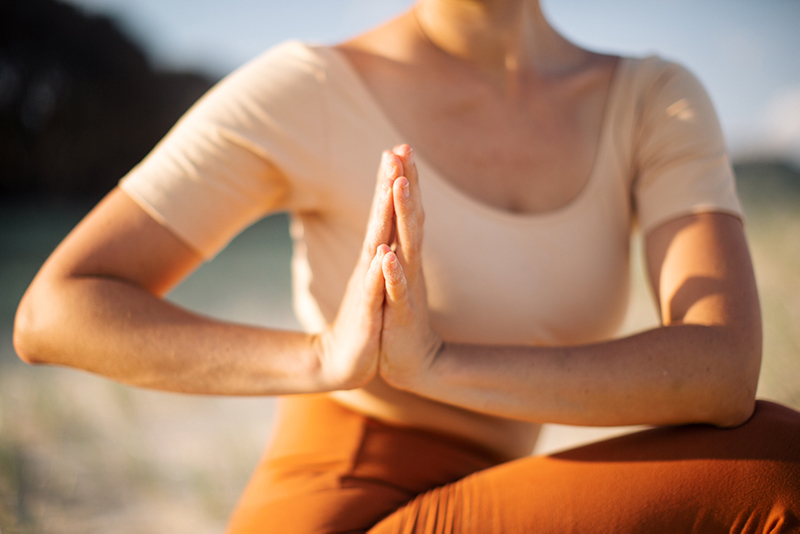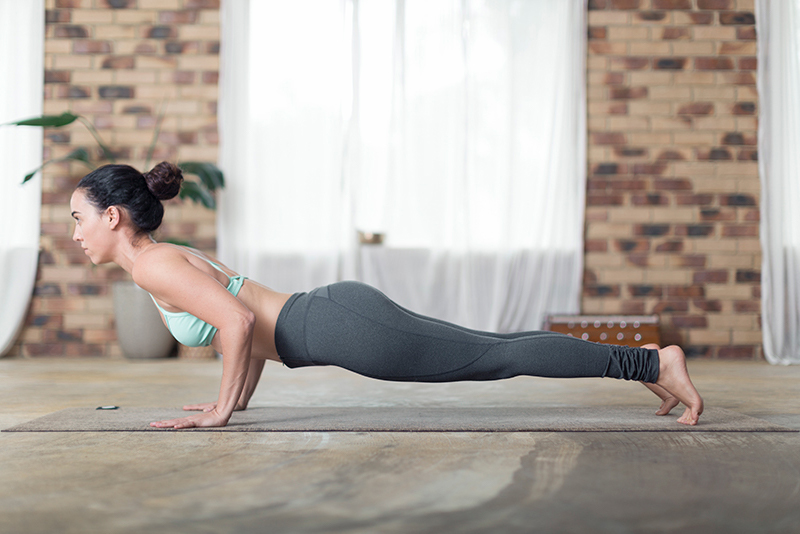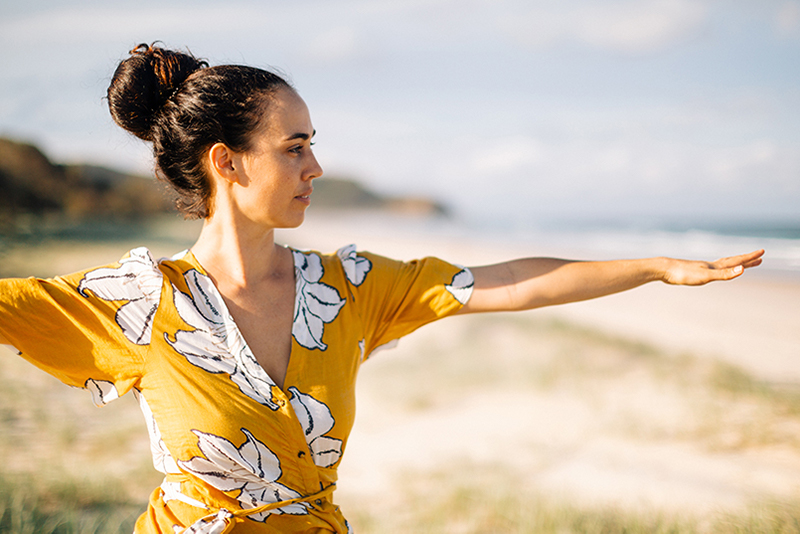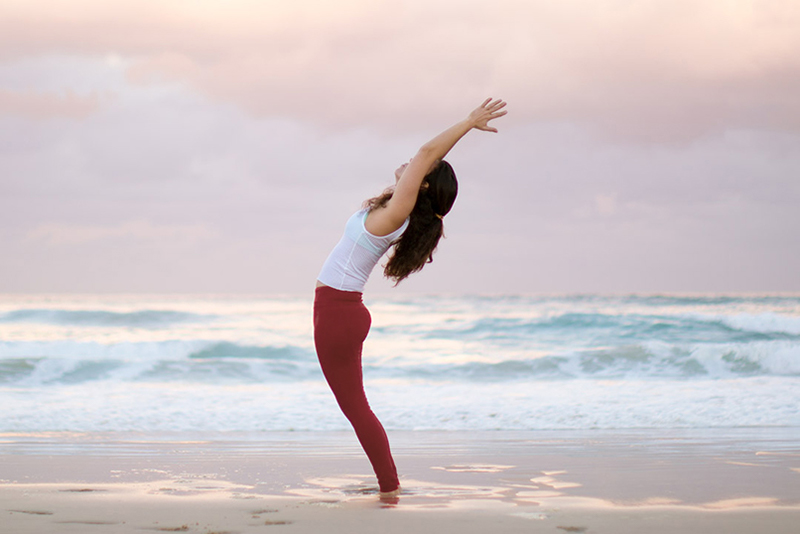There’s a new prop on the block and it’s making your yoga practice extra juicy. Here’s everything you need to know to cultivate your own self-myofascial release routine.
Originally published on YogaDigest.com As a mother, I have come to know very well the fine line between feeling like everything is smooth sailing and everything is falling apart. Some days I’ve got my feet firmly planted in the “I’ve got this” camp, and other days I’m just tip-toeing the line, teetering on the edge of a breakdown. With a mile long to do list, a never ending pile of laundry, a toddler that still wakes up 1 or more times at night, four mouths to feed, and two businesses to run, it can often seem impossible to find the time for self-care. Giving myself permission to do less on my mat is key to squeezing in a much needed practice. A short and simple daily practice can still provide immense mental health benefits. Because time is precious, I pick 5 poses and get straight to the point. This new way of practicing in motherhood has given me the courage to face my challenges with a touch more grace and a lot more laughter. The yoga practice below is designed to cultivate qualities that exist inside all mothers but sometimes feel out of reach. You’ll need a bolster and a mat, or a
originally published on Healthline.com Get your yoga start with Tiffany Cruikshank, founder of Yoga Medicine Known as a teacher’s teacher, international yogi, author, and health and wellness expert Tiffany Cruikshank founded Yoga Medicine as a platform to connect people and doctors with experienced yoga teachers. Yoga Medicine’s ever-expanding community of teachers are trained to understand body anatomy, biomechanics, physiology, and the traditional practice of yoga. And with this fortitude of knowledge, they’re able to create individualized, effective yoga programs for each student. Ready to channel your inner yogi? Get your start with this comprehensive guide, crafted by Tiffany and her team of accomplished Yoga Medicine teachers, trainers, and contributors. The history of yoga and how it developed into the practice you know today By Dana Diament, a Yoga Medicine instructor based in Byron Bay, Australia. You can follow her journey at danadiament.com. Ask any yoga practitioner to define yoga, and you’re likely to get a myriad of answers. For some, it’s a way to feel good in their bodies. For others, it’s a spiritual practice, and for many, a way of life. But regardless of your approach, yoga can help reshape and unravel your habitual or unconscious patterns. Practicing yoga helps provide a foundation and tools to
Let’s face it – the holiday season is a time of year loved for its excitement but dreaded for its chaos. Despite how early we get started, the to-do list seems never ending. From the wild goose chase hunting down just the right presents, the late nights in the office meeting deadlines, to organizing the perfect holiday get-together for the extended family, we keep going and going, having convinced ourselves we are the energizer bunny or its close cousin. Caught up in the frenzy of getting it all done, it’s easy to forget about a small important detail – for best results our batteries do need to be recharged. A yoga practice that encourages stillness can be just the right tonic to leave you feeling invigorated and grounded, and ready for another round of merry making. 1.Chandra Bheda Pranayama How: Find a comfortable seat by sitting on the edge of a blanket or cushion so that your hips are higher than your knees. Rest your left hand on your lap. Use your right hand to create Vishnu Mudra – place your thumb on the right nostril, fold your 2nd & 3rd finger in towards your palm, and hover your 4th & pinky finger
With so many yoga methods and lineages to choose from, confusion about asana alignment is common. Here, Yoga Medicine teacher Dana Diament uses smart anatomy to debunk some common alignment myths. ORIGINAL:SEP 29, 2016 yogajournal.com If you jump around between yoga teachers or lineages, confusion about asana alignment is understandable. Here, Yoga Medicine teacher Dana Diament debunks some common myths with wise anatomy. One of my favorite things about yoga is the variety of yoga methods and lineages to choose from. But with all of those choices, you may be left feeling confused about alignment. The proliferation of yoga asana images in recent years only makes matters trickier as more and more students strive to recreate the poses exactly as they see them. Many teachers are also taught to instruct poses to textbook standards, which were not necessarily created for Western or female bodies. This dogmatic approach to alignment sets the scene for certain myths to take hold in our yoga communities about the “right” way to do a pose. To shed light on a few of these myths, let’s take a closer look at some of the key anatomical concepts behind some common yoga poses. Myth 1: In Chaturanga, the elbows should be
originally published in WellBeing magazine by Kate Duncan. You listen to your yoga teacher, you wonder if they do silly things in life like you and maybe, one day, you want to become one. Here, five teachers share what they’ve learnt on their path. Dana Diament Byron Bay, Australia What insights have you gained while teaching yoga? I’ve seen many practitioners (myself included) set unhealthy expectations of how their yoga practice should look and feel. Of course, we want to put in a sincere effort, but it seems to me that the harder we are on ourselves, the less benefit we derive. Rather, when we practise from compassion, our potential for transformation is limitless. We discover a gentle kind of strength that fosters our patience, allowing the practice to unfold in its own timeline. My hope is that this longevity we create in our practice sustains our yoga as the source of our healing, grounding, inspiration — or whatever reason it is that you practice — for many, many years. What are some of your tips for aspiring yoga teachers? Dive in. Listen to that voice within, the one speaking to you now, which says, “I want to teach yoga.” Find a quality 200-hour teacher training program
With the warmer weather and longer days, summer is a popular time to put your running shoes back on. The sweet smell in the air and warm sun on your skin draws you outdoors, and with the endorphin kick you get from running, it’s easy to push your body further than what it’s ready for. However, by adding in a few yoga poses, you can support your body and prevent injuries to help you go that extra mile. Yoga helps to prevent injuries by addressing the muscular imbalances created by running and increasing both strength and flexibility. While in the poses, stay focused on your breath and observe your body’s sensations. This helps to build your awareness, which is also key to preventing injuries. The more you can tune into your body, the better you’ll be able to know what your body needs before, during, and after a run to stay healthy and safe. Incorporate the yoga poses below to keep you running throughout the summer. Downward facing dog Benefits: Stretches hamstrings, calves, and back muscles. Start on hands and knees. Hug your arms into the shoulders and push the floor away with your hands. Lean back, tuck your toes and lift your hips to make
For many of us, the day doesn’t seem to stop until the minute our head hits the pillow at night. In that precious moment, we think our refuge has finally arrived but we close our eyes and sleep couldn’t seem farther away. Our mind won’t stop chattering. The aches in our body feel more vivid than ever. We start to wonder just how long it will take to fall asleep or whether we’ll get a good night’s sleep at all. This common scenario is a symptom of our body stuck in the sympathetic nervous system, our fight or flight mode. We need this part of our nervous system as it gives us the adrenaline we need to survive in the world – which these days is more about waiting in lines, dealing with traffic, meeting deadlines, paying our bills, getting the children to school than fighting off an attack from a tiger. However, when it comes to falling asleep, we need our body to switch to our parasympathetic nervous system, our rest and repair mode. In an ideal scenario, our bodies can easily switch back and forth between the two modes, the way we can flick a light on and off. Because
Maybe this year your New Year’s resolution focused more on the mind and soul than on hitting the gym. Maybe your goal is to become more connected with yourself, rather than connected to your cell phone. Or maybe it is to be more mindful and experience each and every moment to the fullest. If that sounds like you, then you probably also noticed that it’s much, much easier said than done. Being mindful and achieving self-awareness and an inner calmness can be one of the most challenging things we work on, especially with so much going on around us. Two Yoga Medicine instructors were able to weigh in on this subject for us to help guide us down our own personal paths of enlightenment. Yoga Medicine instructor Dana Diament says mindfulness is the practice of noticing your thoughts or sensations in any given moment. “Because it can be done anywhere and at any time of day, simple mindfulness practices can be incorporated into your everyday life in just a few minutes,” she said. Yoga Medicine instructor Kaitlyn Hochart says you should start small when it comes to finding your meditation practice, and make sure to head outside. Dana’s tips: How to practice mindfulness Tip #1 Notice your
Below is a recap I wrote in 2015 after attending and assisting a Yoga Medicine 50hr advanced teacher training module on the Spine in Napa, California. A healthy spine plays a crucial role in our body’s ability to move efficiently as well as protect and house our spinal cord. Dysfunction or injuries to our spine has implications on both our mobility and our nervous system, and therefore even small changes have the potential to make a big impact to alleviating pain these injuries and dysfunctions can cause. Because of its direct connection to the nervous system, when working with spinal dysfunction, a great place to start is with the breath. This can be especially helpful when you don’t have a diagnosis or you don’t know what to do with a client. The breath is a powerful tool to feed and nourish our parasympathetic nervous system, the rest and digest system responsible for healing and repairing the body. In Napa, I personally noticed how the extra pranayama that week improved my back and hip pain. Tensegrity Before diving into spine dysfunction and application, let’s understand the concept of tensegrity. Think of a trampoline. If you were to cut one of the springs, all of the







